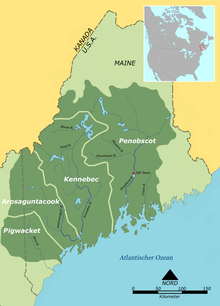The Pequawket were a Native American band of Abenaki people. In the 18th century, they lived in New Hampshire and Maine.[2]
 Approximate original location of the Pequawket (Pigwacket) and other Abenaki groups, ca. | |
| Total population | |
|---|---|
| extinct as a tribe in the early 19th century[1] | |
| Regions with significant populations | |
| New Hampshire, Maine | |
| Religion | |
| Indigenous religion | |
| Related ethnic groups | |
| Other Abenaki peoples |
Territory edit
The Pequawket lived near the headwaters of the Saco River and near what is now Carroll County, New Hampshire[2] and Oxford County, Maine. Their primary town, also called Pequawket, was near Fryeburg, Maine.[2]
Name edit
The etymology of Pequawket is disputed but might come from pekwakik, which translates "at the hole in the ground".[2]
Their name is also spelled 'Pigwacket and many other spelling variants, and Dean Snow suggests it may have come from Eastern Abenaki apíkwahki, "land of hollows").[3]
History edit
18th century edit
On April 16, 1725, the Pequawket fought the Battle at Pequawket against Captain John Lovewell and 50 English troops. The Pequawket killed Lovewell; however, the British killed Chief Paugus. After that skirmish, the Pequawket and the Arosaguntacook withdrew to the Connecticut River. The Arosaguntacook migrated north to Canada, where they settled in Saint-François-du-Lac, Quebec, while the Pequawket stayed there through the American Revolutionary War. Some returned to their homeland in the late 18th century.[2]
Notable Pequawket edit
- Nescambious, an 18th-century Pequawket chief
- Molly Ockett (ca. 1740–1816), herbal healer and craftswomen[1]
See also edit
References edit
- ^ a b "Molly Ockett and Her World". Bethel Historical Society. Retrieved 2017-11-12.
- ^ a b c d e Hodge, Frederick Webb (1907). Handbook of American Indians North of Mexico: N-Z. Washington, DC: US Government Printing Office. p. 229.
- ^ Snow, Dean R. 1978. "Eastern Abenaki". In Northeast, ed. Bruce G. Trigger. Vol. 15 of Handbook of North American Indians, ed. William C. Sturtevant. Washington, DC: Smithsonian Institution, pg. 146